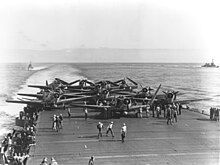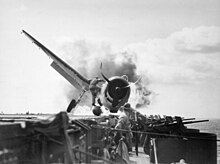USS Enterprise (CV-6)
Enterprise and the other ships of Task Force 8 (TF 8) departed Pearl Harbor on 28 November 1941 to deliver Marine Fighter Squadron 211 (VMF-211) to Wake Island nearly 2,500 miles (4,000 km) due west.
[13] Dixon and his two crewmates, bombardier Anthony J. Pastula and gunner Gene Aldrich, survived for 34 days in a small rubber raft after their food and water were washed overboard, before drifting ashore on the atoll of Pukapuka, where the natives fed them and notified Allied authorities.
Dixon was awarded the Navy Cross for "extraordinary heroism, exceptional determination, resourcefulness, skilled seamanship, excellent judgment and highest quality of leadership.
In two waves, 64 airplanes attacked and for the loss of six of their number, sunk only a small gunboat and damaged the light cruiser Katori, the minelayer Tokiwa, and five other ships.
The task force, its presence known to the enemy after a Japanese picket boat radioed a warning, reversed course and returned to Pearl Harbor on 25 April.
On 28 May, Enterprise departed Pearl Harbor as Rear Admiral Raymond A. Spruance's flagship with orders "to hold Midway and inflict maximum damage on the enemy by strong attrition tactics".
After a month of rest and overhaul, Enterprise sailed on 15 July 1942 for the South Pacific, where she joined TF 61 to support the amphibious landings in the Solomon Islands on 8 August.
[7] In the ensuing Battle of the Eastern Solomons, the light carrier Ryūjō was sunk, and the Japanese troops intended for Guadalcanal were forced back.
Enterprise suffered the most heavily of the American ships; three direct bomb hits and four near misses killed 74, wounded 95, and inflicted serious damage on the carrier.
[25][26] The commanding officer of Enterprise, Captain Osborne Bennett "Ozzie B" "Oby" Hardison,[27] notified the Navy Department that "the emergency repairs accomplished by this skillful, well-trained, and enthusiastically energetic force have placed this vessel in condition for further action against the enemy.
"[28][note 4] This remarkable job later won the praise of Vice Admiral William Halsey, Jr., Commander South Pacific Area and the South Pacific Force, who sent a dispatch to the OIC of the Seabee detachment stating, "Your commander wishes to express to you and the men of the Construction Battalion serving under you his appreciation for the services rendered by you in effecting emergency repairs during action against the enemy.
At 09:36, a 500-pound bomb hit Kinugasa's 13.2 mm (0.5 in) machine gun mount in front of the bridge, starting a fire in the forward gasoline storage area.
Near-misses caused additional fires and flooding and a second attack by 17 more Dauntlesses knocked out Kinugasa's engines and rudder and opened more compartments to the sea.
Detached after the battle, the carrier arrived at Espiritu Santo on 1 February, and for the next three months operated out of that base, covering U.S. surface forces up to the Solomons.
Enterprise then steamed to Pearl Harbor where, on 27 May 1943, Admiral Chester Nimitz presented the ship with the first Presidential Unit citation awarded to an aircraft carrier.
In the summer of 1943, with the new Essex-class and Independence-class carriers joining the American Pacific Fleet, Enterprise was temporarily relieved of duty, and on 20 July, she entered Puget Sound Naval Shipyard for a much-needed overhaul.
[7] Over the course of several months, Enterprise received an extensive refit, which included, among other upgrades, new anti-aircraft weapons and an anti-torpedo blister that significantly improved her underwater protection.
Aware of a major Japanese attempt to break up the invasion of Saipan, Admiral Spruance, now Commander 5th Fleet, positioned TF 58 to meet the threat.
A planned midnight strike against the Japanese fleet by night-flying Enterprise pilots was cancelled because of the recovery and rescue operations required after the dusk attack.
From 10 to 20 October, her aviators flew over Okinawa, Formosa, and the Philippines, blasting enemy airfields, shore installations, and shipping in preparation for the assault on Leyte.
In the Battle of Leyte Gulf (23–26 October), Enterprise planes struck all three groups of enemy forces, battering battleships and destroyers before the action ended.
[39][40] it joined TG 38.5 and swept the waters north of Luzon and of the South China Sea during January 1945, striking shore targets and shipping from Formosa to Indo-China including an attack on Macau.
Two weeks later, she proceeded to Boston for installation of additional berthing facilities, then began a series of three Operation Magic Carpet voyages to Europe, bringing home more than 10,000 veterans in her final service to her country.
[45] On this nine-day trip, she encountered four storms, some with winds of 80 miles per hour (130 km/h) that caused 75-foot (23 m) waves that swamped the forecastle deck in water up to 10 feet (3.0 m) deep.
[45] With the commissioning of over two dozen larger and more advanced aircraft carriers by end of 1945, Enterprise was deemed surplus for the post-war needs of America's navy.
[47] Subsequent attempts were made at preserving the ship as a museum or memorial, but fund-raising efforts failed to raise enough money to buy the vessel from the Navy, and Enterprise was sold on 1 July 1958 to the Lipsett Corporation of New York City for scrapping at Kearny, New Jersey.
A promise was made to save the distinctive tripod mast for inclusion in the Naval Academy's new football stadium, but was never fulfilled; instead, a memorial plaque was installed at the base of what is still called "Enterprise Tower."
Naval Academy,[48] where it is traditionally rung only after Midshipmen victories over West Point; and the sixteen-foot (4.9 m), one-ton nameplate from the ship's stern, which sits near a Little League park in River Vale, New Jersey.
The citation states: For consistently outstanding performance and distinguished achievement during repeated action against enemy Japanese forces in the Pacific war area, 7 December 1941, to 15 November 1942.
Her aggressive spirit and superb combat efficiency are fitting tribute to the officers and men who so gallantly established her as an ahead bulwark in the defense of the American nation.













